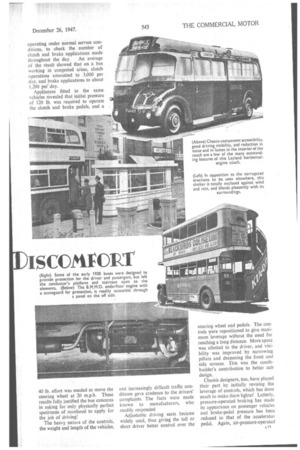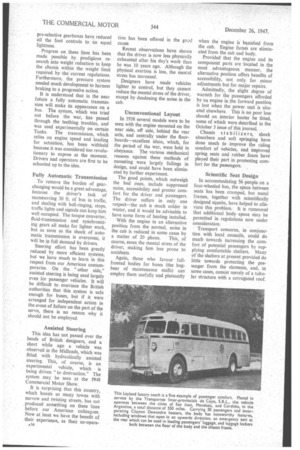YESTERDAY, LUXURY
Page 44

Page 45

Page 46

If you've noticed an error in this article please click here to report it so we can fix it.
is ir()--FAV ISCONTOET
DURING the past 20 years, much has been done to improve the comfort of passengers and crews of buses and coaches. In the late 1920's the double-decker with a covered top appeared. At first it was considered that the high centre of gravity would make the vehicle topheavy,but this proved to be.a fallacy, and the only troubles which occurred were caused by buses passing under bridges that were too low.
Shortly before this time, the driver had been given the benefit of a windscreen, complete with windscreen wiper. This was the cause of much controversy -among drivers, who were at first averse, to being boxed in. Nevertheless, the windscreen became popular during bad weather, and in one area the drivers decided tO call a strike unless all.the open-fronted vehicles were converted within the space of three months.
Illusory Draughts ?
Soon afterwards a general complaint was received that the cabs were draughty In all the years before windscreens were fitted there had been no complaint of discomfort from the drivers, yet, given just a little comfort, they demanded still more. Whether the draught was fact or fancy has never been decided, but a narrow wood fillet fitted to the side of the cab was convincing to the driver that something was being done, and the subject died a natural death.
By this time the enclosed staircase had appeared at the rear of the vehicle and the conductor was assured of a "dry" journey. Shortly before this innovation was intro
A34 duced there had been much talk about the discomforts suffered by conductors`, although the matter had not been discussed in the days of the open-top bus.
Interior diffused lighting became a popular feature, but it was found that to obtain the necessary lighting for reading, the wattage had to be nearly doubled. Besides taking a heavy toll of •the batteries of a double-decker, it also became a nightmare to the electricians, who had to remove the complete panel to replace one lamp.
In the early 1930's the larger concerns started experiments with compression-ignition engines, with . the disapproval of drivers , and maintenance staffs. Unfortunately, many oil-engined vehicles made their appearance in winter time, when starting difficulties were most prone to occur, and the driver's cab was considerably colder because of the higher thermal efficiency of the engine.
Having survived the winter periods and the maintenance staffs having increased their knowledge of oilers, the drivers began to enjoy the extra engine power, and found the cabs more comfortable in the summer time. The maintenance men also came to like the oiler, as it was less troublesome to look after than the petrol engine.
Pre-selective gears made their appearance shortly after the oil engine. The drivers looked upon this as a " crank " idea, especially. when great trouble occurred because the cone-clutch of the top speed caused the gears to jam.. A modification to the angle of the cone soon put this matter , right and the preselectiVe box became popular, especially on the more heavily congested routes,
In the middle 1930's the drivers began to feel their power, and asked for shorter hours or, alternatively, for a lighter vehicle to drive. Keen research was made into the effort required to drive a double-deck bus and some interesting data were brought to light.
Counter Meters were fitted to buses
40 lb. effort was needed to move the steering wheel at 20 m.p.h. These results fully justified the bus concerns in asking for only physically perfect specimens of manhood to apply for the job of driving!
The heavy natin e of the controls, the weight and length of the vehicles, and increasingly difficult traffic conditions gave credence to the drivers' complaints. The facts were made known to manufacturers, who readily responded
Adjustable driving seats became widely used, thus giving the tall or . short driver better control over the steering wheel and pedals. The controls were repositioned to give maximum leverage without the need for reaching a long distance. More space was allotted to the driver, and visibility was improved by narrowing pillars and deepening the front and side screens. This was the coachbuilder's contribution to better cab design., Chassis designers, too, have played their part by initially revising the leverage of controls, which has done much to make them lighter'. Latterly, pressure-operated braking has made its appearance on passenger vehicles and brake-pedal pressure has been reduced to that of the accelerator pedal. Again, air-pressure-operated
pre-selective gearboxes have reduced all the foot controls to an equal lightness.
Progress on these lines has been made possible by prodigious research into weight reduction to keep the chassis within the weight limit required by the current regulations. Furthermore, the pressure system needed much development to harness braking to a progressive action.
It is understood that in the near future a fully automatic transmission will make its appearance on a bus. The system, which was tried out before the war, hasP passed through the teething troubles, and was used experimentally on certain Tanks. The transmission, which relies on engine speed and loading for actuation, has been withheld because it was considered too revolutionary to expose at the moment. Drivers and operators are first to be schooled up to the idea.
Fully Automatic Transmission
To remove the burden of gearchanging would be a great advantage, because the driver's task of manceuvring 30 ft. of bus in traffic, and dealing with bell-ringing, stops, traffic lights and signals can keep him well occupied. The torque converter, fluid-transmission and synchronizing gears all make for lighter work, but as soon as the shock of automatic transmission is overcome, it will be in full demand by drivers.
Steering effort has been greatly reduced by more efficient systems, but we have much to learn in this respect from our American contemporaries. On the "other side," assisted steering is being used largely even for passenger vehicles. It will be difficult to convince the British authorities that this system is safe enough for buses, but if it were arranged for independent action in the event of failure on the part of the servo, there is no reason why it should not be employed.
Assisted Steering
This idea has not passed over the heads of British designers, and a short while ago a vehicle was observed in the Midlands, which was fitted with hydraulically assisted steering. This, of course, is an experimental vehicle, which is being driven "to destruction." The system may be seen at the 1948 Commercial Motor Show.
It is surprising that this country, which boasts so many towns with narrow and twisting streets, has not produced something on these lines before our American colleagues. Now at least we have the benefit of their experience, as their co-opera tion has been offered in the goad cause.
Recent observations have shown that the driver is now less physically exhausted after his day's work than he was 10 years ago. Although the physical exertion is less, the mental stress has increased.
Designers have made vehicles lighter to control, but they cannot reduce the mental stress of the driver, except by deadening the noise in the cab.
Unconventional Layout
In 1938 several models were to be seen with the engine mounted on the near side, off side, behind the rear axle, and centrally under the floorboards—excellent ideas, which, for the period of the war, were held in abeyance. The various mechanical reasons against these methods of mounting were largely failings in design, and could have been eliminated by further experiment.
The good points, _which outweigh the bad ones, include suppressed noise, accessibility and greater comfort for the driver and passengers. The driver suffers in only one respect—the cab is much colder in winter, and it would be advisable to have some form of heating installed.
With the engine in an alternative position from the normal, noise in the cab is reduced in some cases by a matter of 20 phons. This, of course, eases the mental stress of the driver, making him less prone to accidents.
Again, those who favour fullfronted bodies for buses (the bugbear of maintenance staffs) can employ them usefully and pleasantly when the engine is bqnished from the cab. Engine fumes are eliminated from the cab and body.
Provided that the engine and its component parts are located in the most advantageous, manner, the alternative position offers benefits of accessibility, not only for minor adjustments but for major repairs.
Admittedly, the slight degree of warmth for the passengers afforded by an engine in the forward position is lost when the power unit is situated elsewhere. This is no poor loss should an interior heater be fitted, some of which were described in the October 3 issue of this journal.
Chassis stabilizer s, shock absorbers and soft springing have done much to improve the riding comfort of vehicles, and improved spring seats and rubber foam have played their part in promoting comfort for the passengers.
Scientific Seat Design
In accommodating 56 people on a four-wheeled bus, the space between seats has been cramped, but metal frames, together with scientifically designed squabs, have helped to alleviate this problem. It is rumoured that additional body space May be permitted in regulations now under consideration.
Transport concerns, in conjunction with local councils, could do much towards increasing the comfort of potential passengers by supplying comfortable shelters. Many of the shelters at present provided do little towards protecting the passenger from the elements, and, in some cases, consist merely of a tubular structure with a corrugated roof.












































































